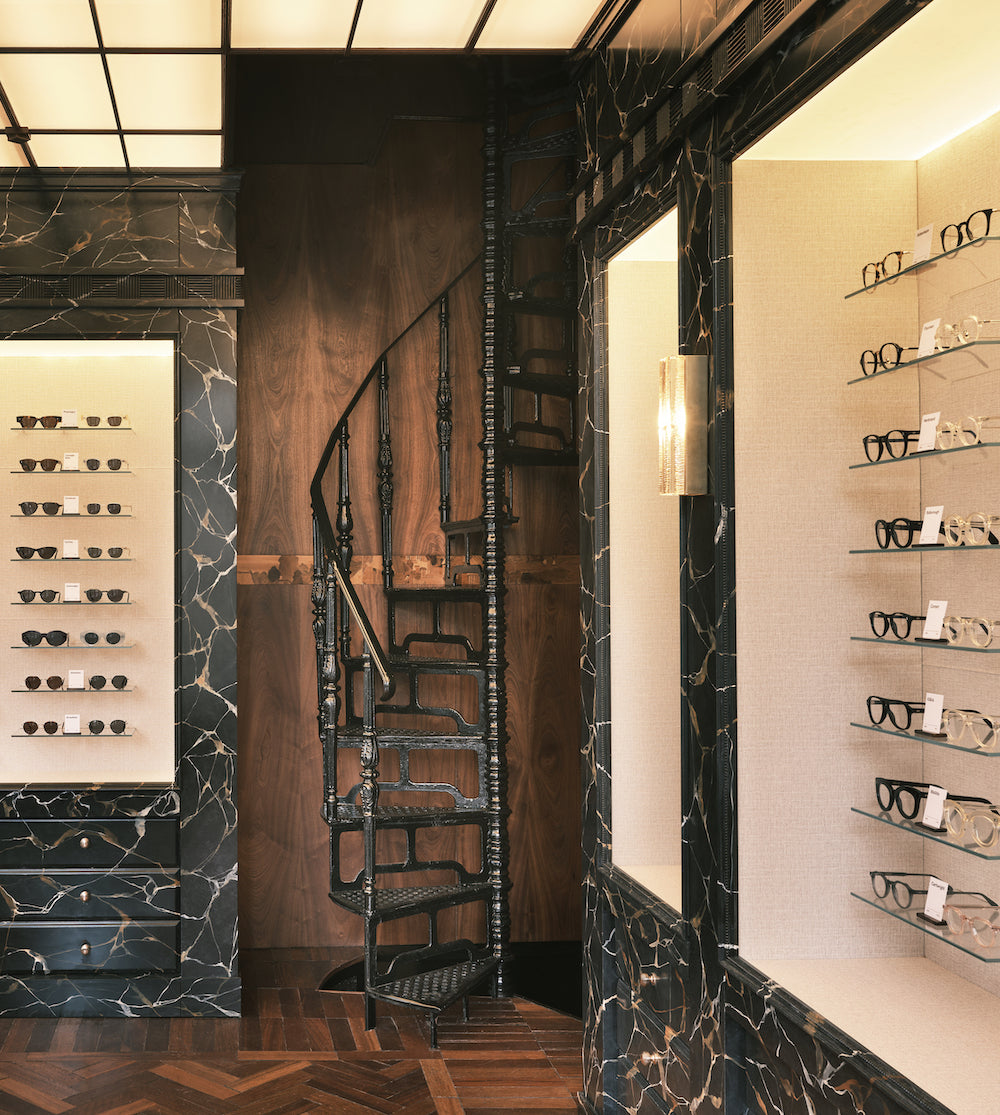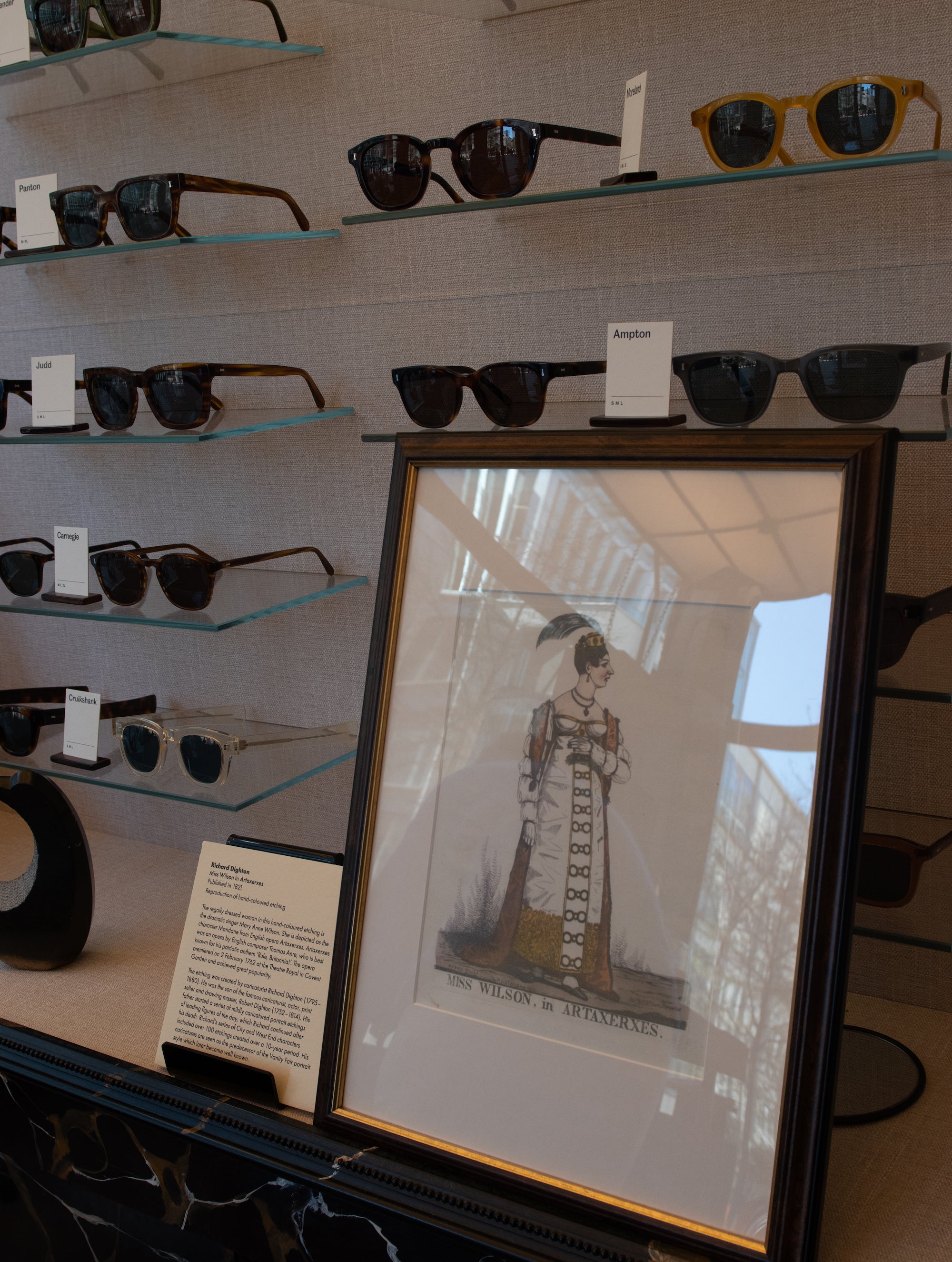The Cubitts store at 123 Cheapside has a long and varied history. Amongst former occupants were Tragaer and Son, purveyors of humorous sporting prints. We asked Emma Stirling-Middleton of London's Cartoon Museum about the shop, it's place in the historical landscape of political cartoons, and the enduring legacy of satirical cartoons today.
Cubitts: Tell us about the history of satirical cartoons in the UK.
Emma Stirling-Middleton: When you say ‘cartoon’ most people think Mickey Mouse, Looney Toons, Scooby Doo, or another of their American animated siblings. I will forgive you for assuming that cartoons and comics were American. But alas no, the cartoon is in fact a British creation.
The word ‘cartoon’, as it is used today, can be traced very precisely to London, 15 July 1843.
It was on this day that the artist John Leech, aged 25, produced a whole page drawing entitled 'Cartoon, No.1: Substance and Shadow’ for iconic British magazine of humour and satire Punch. The drawing attacked a government-sponsored exhibition of fresco designs for murals to adorn the walls of the newly rebuilt Houses of Parliament (the old building having burnt down). In classical art history, a preparatory drawing for a fresco is called a ‘cartoon’. Leech's drawing shows a crowd of visitors who are clearly experiencing poverty and disability attending the grandiose exhibition on one of the 'free' public days. The drawing accompanied an editorial which saw the show as a waste of public money at a time when Londoners were starving: 'The poor ask for bread and the philanthropy of the State accords - an exhibition.'
Five more 'cartoons' on social issues (by various artists) appeared in the following weeks and eventually the magazine's main weekly whole-page drawing - previously known as the ‘big cut’ (or large engraving) and entitled ‘Punch's Pencillings’ - became known as the Cartoon (and its artist the Cartoonist). Later, by association, all the humorous or satirical sketches and joke drawings in the magazine were referred to as 'cartoons'.
As Steve Bell points out in our museum’s permanent collection display at the museum, the first cartoon wasn’t really intended to be funny. It was to hold the powerful to account. It was to expose injustice, to ridicule, to disturb, to express outrage and dissatisfaction.
Since that day back in 1843, the evolution of cartoons has exploded into a thousand different genres and forms, from comic books to tv shows to video games. But the tradition of satirical cartooning is still going strong in newspapers across the country and is an established and powerful form of journalism across the world.
Though this was the first time the word ‘cartoon’ was used, the birth of the satirical cartoon can be traced back to over 100 years before, with a small group of maverick artists creating savage and totally unprecedented works in London. These guys were totally bad ass punks.
Emma Stirling-Middleton: When you say ‘cartoon’ most people think Mickey Mouse, Looney Toons, Scooby Doo, or another of their American animated siblings. I will forgive you for assuming that cartoons and comics were American. But alas no, the cartoon is in fact a British creation.
The word ‘cartoon’, as it is used today, can be traced very precisely to London, 15 July 1843.
It was on this day that the artist John Leech, aged 25, produced a whole page drawing entitled 'Cartoon, No.1: Substance and Shadow’ for iconic British magazine of humour and satire Punch. The drawing attacked a government-sponsored exhibition of fresco designs for murals to adorn the walls of the newly rebuilt Houses of Parliament (the old building having burnt down). In classical art history, a preparatory drawing for a fresco is called a ‘cartoon’. Leech's drawing shows a crowd of visitors who are clearly experiencing poverty and disability attending the grandiose exhibition on one of the 'free' public days. The drawing accompanied an editorial which saw the show as a waste of public money at a time when Londoners were starving: 'The poor ask for bread and the philanthropy of the State accords - an exhibition.'
Five more 'cartoons' on social issues (by various artists) appeared in the following weeks and eventually the magazine's main weekly whole-page drawing - previously known as the ‘big cut’ (or large engraving) and entitled ‘Punch's Pencillings’ - became known as the Cartoon (and its artist the Cartoonist). Later, by association, all the humorous or satirical sketches and joke drawings in the magazine were referred to as 'cartoons'.
As Steve Bell points out in our museum’s permanent collection display at the museum, the first cartoon wasn’t really intended to be funny. It was to hold the powerful to account. It was to expose injustice, to ridicule, to disturb, to express outrage and dissatisfaction.
Since that day back in 1843, the evolution of cartoons has exploded into a thousand different genres and forms, from comic books to tv shows to video games. But the tradition of satirical cartooning is still going strong in newspapers across the country and is an established and powerful form of journalism across the world.
Though this was the first time the word ‘cartoon’ was used, the birth of the satirical cartoon can be traced back to over 100 years before, with a small group of maverick artists creating savage and totally unprecedented works in London. These guys were totally bad ass punks.


C: Cubitts Cheapside was once the location of a ‘Humourous and Sporting Print Shop’ – what is the role of London specifically in the history of cartoons?
ES-M: In the late 1700s, the use of prints to disseminate social and political commentary emerged as a vibrant and thriving British tradition. These prints often took the form of caricatures - from the Italian carico and caricare, meaning ‘to load’ and ‘exaggerate’. Caricatures exaggerate and distort human characteristics in scenes which often convey social or political meaning. These caricatures were the forerunner to cartoons as we know them today.
Eighteenth-century London was a seething, fizzing, beautiful mess, a tinder box practically made for the birth of the satirical cartoon.
The population was swelling as unprecedented numbers of people moved from countryside to city. It was particularly popular amongst the nation’s youth, with thousands of young people moving to London every year. Sex, violence, crime and debauchery were common fare, captured with such elegance by artist William Hogarth (1697–1764), ‘the grandfather of the political cartoon’.
It was a politically turbulent period, from the French Revolution to the Regency crises resulting from George III’s poor mental health, and the matters of the day were debated with revelry and vigour at the popular coffee houses which were cropping up across the capital.
It is within this context that we find the bold and visionary artists who shaped the medium of satirical cartooning: James Gillray (1756–1815), George Cruikshank (1792–1878) and Thomas Rowlandson (1756/7–1827). Two of these pioneering figures, Gillray and Rowlandson, are featured in the pop-up display at Cubbitts Cheapside.
Gillray was the leading caricaturist of the late 1700s, known as ‘the father of the political cartoon’. He created social and political satires, using great beauty, inventiveness and skill to attack the leading figures of the day including George III, Queen Charlotte, the Prince of Wales, Napoleon, William Pitt and Charles Fox. Described in his lifetime as ‘the foremost living artist in the whole of Europe’, his work laid the foundations for the art of newspaper cartooning as we know it today.
Thomas Rowlandson was a watercolourist, illustrator, caricaturist, etcher and printmaker. Studying at the Royal Academy from the age of 15, he was one of the great masters of political satire and social observation of the Georgian period. While Gillray is most celebrated for his depictions of political figures, it is Rowlandson’s images of ordinary people which are most admired.
The works of these artists, and others following in their footsteps, were hugely popular, being widely disseminated in print shops, coffee-houses and on the streets. The period is now known as the golden age of caricature and satire in Britain.
The (delightfully) curious little building which is home to Cubitts Cheapside is part of this London history of satirical prints.
In the nineteenth century the site was home to the shop of Gabriel Shear Tregear, a publisher of caricatures and prints. The windows would have once been filled with prints and caricatures similar to those in our display there today.
On 7 May 1832 the Times newspaper reported that a young boy named William Gunton had been busy admiring Tregear’s window display when a passing wagon caught him by the arm, almost severing it from his body. It was later amputated at St Bartholomew’s Hospital. The report continued: “The corner of Wood-street is rendered exceedingly dangerous by the exhibition of caricatures, as it invariably induces a crowd to assemble round the shop. On the Saturday previous, a gentleman named Bragge nearly lost his life, within a few yards of the same spot, and numerous robberies are continually occurring.”
A policeman was later stationed on the corner, and Treager was forced to reduce the number of prints and caricatures on display.
ES-M: In the late 1700s, the use of prints to disseminate social and political commentary emerged as a vibrant and thriving British tradition. These prints often took the form of caricatures - from the Italian carico and caricare, meaning ‘to load’ and ‘exaggerate’. Caricatures exaggerate and distort human characteristics in scenes which often convey social or political meaning. These caricatures were the forerunner to cartoons as we know them today.
Eighteenth-century London was a seething, fizzing, beautiful mess, a tinder box practically made for the birth of the satirical cartoon.
The population was swelling as unprecedented numbers of people moved from countryside to city. It was particularly popular amongst the nation’s youth, with thousands of young people moving to London every year. Sex, violence, crime and debauchery were common fare, captured with such elegance by artist William Hogarth (1697–1764), ‘the grandfather of the political cartoon’.
It was a politically turbulent period, from the French Revolution to the Regency crises resulting from George III’s poor mental health, and the matters of the day were debated with revelry and vigour at the popular coffee houses which were cropping up across the capital.
It is within this context that we find the bold and visionary artists who shaped the medium of satirical cartooning: James Gillray (1756–1815), George Cruikshank (1792–1878) and Thomas Rowlandson (1756/7–1827). Two of these pioneering figures, Gillray and Rowlandson, are featured in the pop-up display at Cubbitts Cheapside.
Gillray was the leading caricaturist of the late 1700s, known as ‘the father of the political cartoon’. He created social and political satires, using great beauty, inventiveness and skill to attack the leading figures of the day including George III, Queen Charlotte, the Prince of Wales, Napoleon, William Pitt and Charles Fox. Described in his lifetime as ‘the foremost living artist in the whole of Europe’, his work laid the foundations for the art of newspaper cartooning as we know it today.
Thomas Rowlandson was a watercolourist, illustrator, caricaturist, etcher and printmaker. Studying at the Royal Academy from the age of 15, he was one of the great masters of political satire and social observation of the Georgian period. While Gillray is most celebrated for his depictions of political figures, it is Rowlandson’s images of ordinary people which are most admired.
The works of these artists, and others following in their footsteps, were hugely popular, being widely disseminated in print shops, coffee-houses and on the streets. The period is now known as the golden age of caricature and satire in Britain.
The (delightfully) curious little building which is home to Cubitts Cheapside is part of this London history of satirical prints.
In the nineteenth century the site was home to the shop of Gabriel Shear Tregear, a publisher of caricatures and prints. The windows would have once been filled with prints and caricatures similar to those in our display there today.
On 7 May 1832 the Times newspaper reported that a young boy named William Gunton had been busy admiring Tregear’s window display when a passing wagon caught him by the arm, almost severing it from his body. It was later amputated at St Bartholomew’s Hospital. The report continued: “The corner of Wood-street is rendered exceedingly dangerous by the exhibition of caricatures, as it invariably induces a crowd to assemble round the shop. On the Saturday previous, a gentleman named Bragge nearly lost his life, within a few yards of the same spot, and numerous robberies are continually occurring.”
A policeman was later stationed on the corner, and Treager was forced to reduce the number of prints and caricatures on display.


C: Has a satirical cartoon ever informed political change?
ES-M: The answer to this question is undoubtedly yes. However, cartoons are not like other works of art, which are generally produced as singular creations. A cartoon is created rapidly with the intention of being printed and circulated and ultimately thrown away. And then the next day there will be another. And then another. And another and another, ad infinitum. Until the general public can no longer remember what the political figure actually looks like and what is caricature. I would argue that it is this ‘death by a thousand cuts’ for the caricatured which is so powerful. Cartoons are fresh air in the lungs of a democracy striving for good health; we are exceptionally privileged to live in a time and a country where it is completely normal to see published satirical images of our leaders.
I believe that political figures are, and always have been, extremely aware of the power of satirical cartoons. The cartoons of British cartoonist David Low were banned in Germany and Italy after 1933 because they were so feared by Hitler and Mussolini. Napoleon Bonaparte was actually a completely average height for his time, but is immortalised as tiny (and furious about it) due to the caricatures of James Gillray, who I mentioned earlier.
So in this sense, I would say that satirical cartoons are hugely powerful and have a far reaching impact on political change.
ES-M: The answer to this question is undoubtedly yes. However, cartoons are not like other works of art, which are generally produced as singular creations. A cartoon is created rapidly with the intention of being printed and circulated and ultimately thrown away. And then the next day there will be another. And then another. And another and another, ad infinitum. Until the general public can no longer remember what the political figure actually looks like and what is caricature. I would argue that it is this ‘death by a thousand cuts’ for the caricatured which is so powerful. Cartoons are fresh air in the lungs of a democracy striving for good health; we are exceptionally privileged to live in a time and a country where it is completely normal to see published satirical images of our leaders.
I believe that political figures are, and always have been, extremely aware of the power of satirical cartoons. The cartoons of British cartoonist David Low were banned in Germany and Italy after 1933 because they were so feared by Hitler and Mussolini. Napoleon Bonaparte was actually a completely average height for his time, but is immortalised as tiny (and furious about it) due to the caricatures of James Gillray, who I mentioned earlier.
So in this sense, I would say that satirical cartoons are hugely powerful and have a far reaching impact on political change.




C: Political satire and cartoons can feature highly sensitive subjects and events. How important is context in displaying a piece that could be seen as offensive to those affected?
ES-M: Generally speaking, I believe that cartoons speak for themselves. The minute you try to explain them or excuse them, something is lost. The dialogue is between cartoonist and viewer. And by their nature, cartoons are usually made to be experienced in newspapers or magazines, so whenever and wherever (and more so now than ever, with the online world of infinite sharing and reproduction).
What is important, I think, is giving people agency over whether or not they interact with the content; no one wants to be walking around minding their own business and then randomly confronted with an offensive image.
A good example of this is in our main display at the museum, a cartoon of Boris Johnson exclaiming a racist slur was blown up and reproduced on the enormous introductory graphic at the beginning of the exhibition (this was a decision made before I worked there, I should add). The intention was absolutely well meaning; the original purpose of the cartoon was to draw attention to the completely unacceptable and offensive nature of Boris Johnson’s racist language. It was printed on the introductory graphic at the museum, I assume, because it illustrates well the workings of the satirical cartoon: to disturb, to disrupt, to hold the powerful to account. However, the problem with the museum graphic is that it is the first thing people see when they enter the gallery. The image is enlarged and its placement gives the viewer no option – they’re seeing it whether they like it or not. And they’re seeing it pretty much before they’ve seen anything else. We’ve had a number of complaints about it and I can’t wait to get rid of it when we re-do the display next year.
ES-M: Generally speaking, I believe that cartoons speak for themselves. The minute you try to explain them or excuse them, something is lost. The dialogue is between cartoonist and viewer. And by their nature, cartoons are usually made to be experienced in newspapers or magazines, so whenever and wherever (and more so now than ever, with the online world of infinite sharing and reproduction).
What is important, I think, is giving people agency over whether or not they interact with the content; no one wants to be walking around minding their own business and then randomly confronted with an offensive image.
A good example of this is in our main display at the museum, a cartoon of Boris Johnson exclaiming a racist slur was blown up and reproduced on the enormous introductory graphic at the beginning of the exhibition (this was a decision made before I worked there, I should add). The intention was absolutely well meaning; the original purpose of the cartoon was to draw attention to the completely unacceptable and offensive nature of Boris Johnson’s racist language. It was printed on the introductory graphic at the museum, I assume, because it illustrates well the workings of the satirical cartoon: to disturb, to disrupt, to hold the powerful to account. However, the problem with the museum graphic is that it is the first thing people see when they enter the gallery. The image is enlarged and its placement gives the viewer no option – they’re seeing it whether they like it or not. And they’re seeing it pretty much before they’ve seen anything else. We’ve had a number of complaints about it and I can’t wait to get rid of it when we re-do the display next year.
C: Is there a line, and if so where is it?
ES-M: We all saw what happened at the offices of Charlie Hebdo back in 2015. The line is a very serious matter.
I get asked this quite often, and honestly I don’t really know the answer. I think the laws around freedom of expression are probably a good baseline.
The great Martin Rowson, cartoonist and trustee of our museum, once told me it is about always punching up (to those with more power than you), never down.
I get asked this quite often, and honestly I don’t really know the answer. I think the laws around freedom of expression are probably a good baseline.
The great Martin Rowson, cartoonist and trustee of our museum, once told me it is about always punching up (to those with more power than you), never down.




C: Do cartoons retain the potency they once had as a tool for social disruption?
ES-M: The power of the cartoon has never been inherent in the object itself; the power of the cartoon is in it being seen. Today cartoons are shared online and can be viewed by millions of people all over the world in an instant.
In 2018, Chinese president Xi JinPing banned the release of Disney’s new Winnie the Pooh movie in China. This was due to the spread of memes and cartoons comparing China’s leader with the cuddly yellow character. I think this ban tells you everything you need to know about the potency of cartoons as a tool for social disruption in recent times.
ES-M: The power of the cartoon has never been inherent in the object itself; the power of the cartoon is in it being seen. Today cartoons are shared online and can be viewed by millions of people all over the world in an instant.
In 2018, Chinese president Xi JinPing banned the release of Disney’s new Winnie the Pooh movie in China. This was due to the spread of memes and cartoons comparing China’s leader with the cuddly yellow character. I think this ban tells you everything you need to know about the potency of cartoons as a tool for social disruption in recent times.
C: Do you think the hyper-focus on the news during the pandemic has put a renewed emphasis on the importance of satire?
ES-M: I think that in challenging times, laughter can be a way of helping us to survive. Satire always thrives in the dark.
ES-M: I think that in challenging times, laughter can be a way of helping us to survive. Satire always thrives in the dark.
C: What is the effect of the digital landscape on the importance of satire?
ES-M: The way in which satirical cartoons are shared with the public has always been in evolution. They began as prints, displayed in windows or viewed by individuals or small groups. They then migrated to magazines and newspapers, circulated to millions. Today, they can be viewed online across the world at the click of a button. Notice how with each evolution, cartoons are reaching a wider and wider audience. The digital landscape expands the number of people cartoons can reach.
Another exciting facet of the digital landscape is that it democratises who can create and share cartoons. Newspapers and magazines remain important bastions of cartoon publication but social media now enables anyone and everyone to create art and share it with the world. This diversification and democratisation of voices in cartooning is significant, necessary and incredibly exciting.
Put these two things together – limitless expansion of creators and audiences – and it seems that cartooning has barely begun its ascent. I can’t wait to see what’s next.
ES-M: The way in which satirical cartoons are shared with the public has always been in evolution. They began as prints, displayed in windows or viewed by individuals or small groups. They then migrated to magazines and newspapers, circulated to millions. Today, they can be viewed online across the world at the click of a button. Notice how with each evolution, cartoons are reaching a wider and wider audience. The digital landscape expands the number of people cartoons can reach.
Another exciting facet of the digital landscape is that it democratises who can create and share cartoons. Newspapers and magazines remain important bastions of cartoon publication but social media now enables anyone and everyone to create art and share it with the world. This diversification and democratisation of voices in cartooning is significant, necessary and incredibly exciting.
Put these two things together – limitless expansion of creators and audiences – and it seems that cartooning has barely begun its ascent. I can’t wait to see what’s next.
